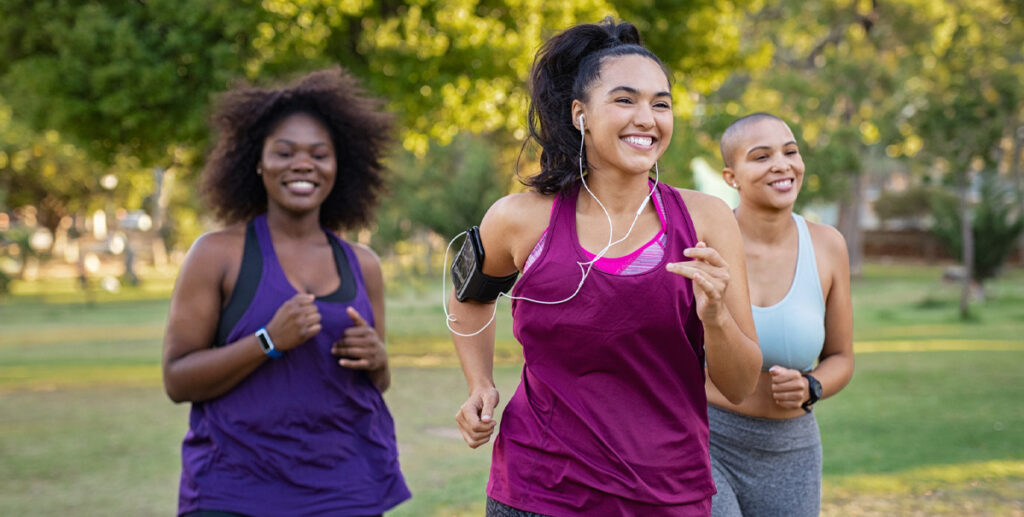Nearly one in two people said that exercising more regularly during the next six months is a top priority for them in order to improve their health and wellness, according to a recent survey.
The survey found that 49% of people said they plan to exercise more often, 48% said they’re going to eat healthier, 39% said that they’re going to prioritize self-care, 28% said that they’ll meditate more, and 23% said that they’re going to take dietary supplements or vitamins.
Since exercise is the top method for how people plan to improve their stress levels during the next six months, now is the perfect time to add running to your regular fitness routine.
Why running? Well, running is the most basic human form of exercise and it’s also ideal for all fitness levels. Plus, running offers a number of impressive health benefits.
How Do You Start Running?
While starting anything new can certainly seem challenging, and even downright scary at first, it’s important to take that first small step toward your goal.
Since the Purely Inspired brand believes that it’s the first small steps and simple wins that bring the most joy in life, we’ve got you covered with six tips that will make it easy for you to get started with your running journey.
So, on your mark, get set, go!
6 Tips To Start Running For Beginners
- Know Your Why
Before you even lace up your sneakers and head out on your first run, it’s important to know why you want to start running in the first place.
A Why We Run survey, which asked 25,000 runners what motivates them to actually go for a run, found that 63% of runners said that their favorite part of a run was when it was finished. Yikes!
The survey also revealed that only 8% of runners said they ran because “they loved running,” and 50% of runners said that they hate running, or merely tolerate it. So, this begs the question: Why do these 25,000 people actually run if they hate running, or merely tolerate it?
It turns out that health and accomplishing individual goals are two of the main motivators for runners. In fact, 41% of runners around the world said that they run in order to achieve a personal goal (such as weight loss or running a marathon), 40% of runners said that they run to be strong, and 35% of runners said that they run in order to improve their body image.
Since it’s not the act of running itself that keeps most runners going, it’s crucial for you to know your why, especially as you start out on your running journey.
2. Get The Right Running Gear
The good news is that you really don’t need that much gear to get started running. However, for a positive running experience, it’s important to make sure that you have all of the right running gear based on your needs.
So, let’s take a closer look at the running gear that you’ll need when you’re first starting out.
Proper Fitting Shoes: While you might be tempted just to use whatever old pair of shoes you have in your house, that may lead to sore knees, a sore back, or blisters that may keep you from running. Since you want to get rid of all the barriers that could keep you from running, treat yourself to new shoes that are fitted and feel good when you wear them.
What should you look for when picking out your running shoes? Comfort! That’s right, researchers found that the most important feature of a running shoe is comfort.
Some other key decision points to consider when it comes to picking out the perfect pair of running shoes are:
- Do you need road-running, trail-running, or cross-training shoes? Your answer will depend on whether you’ll be running mostly on local roads/pavement, on a treadmill at the gym, or if you’re planning on doing trail running. That’s because road-running shoes are designed for pavement, trail-running shoes are designed for off-road routes, and cross-training shoes are designed for gym workouts.
- How much cushion do you want to feel? If you want to feel the connection to the ground beneath you while you run, then you’ll want minimal cushion shoes. On the other hand, if you want thicker, softer foam underfoot while you run, then you’ll want maximum cushion shoes. And if you’re somewhere in between minimal cushion and maximum cushion, then moderate cushion shoes should strike the right balance for you.
- Do you need a specific type of support for your gait? While most runners will be able to choose a neutral running shoe, there are shoes that can help if your foot tends to roll to the far outside or inside while you run.
- Will you be running in the early morning, afternoon, or at night? If you’re planning on running early in the morning before the sun comes up, or after work when the sun has already set, then you may want to purchase running shoes that include some sort of reflective material. This way, it’ll make it easier for drivers to see you in the early morning or at night when you’re running.
- How will you know when it’s time for you to get new running shoes? Typically, a pair of running shoes will last between 400 to 500 miles, or three to four months for regular runners. That said, check your shoes somewhat regularly to see if the midsoles and outsoles are compressed or worn.
Socks: While running shoes tend to get most of the attention, it’s also important to select the correct socks. When choosing socks, go with breathable, snug socks that won’t suffocate your feet. If you like a cushioned feel, try a thicker sock. However, if the thicker sock doesn’t feel comfortable in your shoe, go with a lighter, thinner pair.
Also, avoid wearing 100% cotton socks when you run since the moisture won’t wick away. And since running socks are typically more expensive than regular socks, test them out to see how they perform on your run before you buy a bunch of running socks. If the running socks feel good and perform well on your runs, then go ahead and buy more.
Shorts: Sure, you can use shorts that you already have, but running shorts tend to come in men’s, women’s, and unisex designs for a reason.
Men’s running shorts typically have a longer inseam with a built-in liner that usually offers more support in the groin area, while women’s running shorts usually have a shorter inseam (for shorter legs) and focus on a better fit for a woman’s waist, hips, and thighs.
There are also unisex running shorts, which are a combination of women’s and men’s running shorts. However, unisex running shorts tend not to offer as much support or comfort as gender-specific running shorts.
Running Tops: It’s best to avoid short and long sleeve cotton tops when running since they absorb sweat and/or rain. Instead, go with short and long sleeve running tops that wick away sweat to keep you cooler. Your running tops should also be a good balance between well-fitted and a little baggy.
A Supportive Sports Bra: Research has shown that exercising without proper support can lead to breast pain, sagging, and lower athletic performance. So, in order to prevent pain and stay comfortable and supported, women should prioritize sports bras with higher support when they’re running since running is a high-impact exercise. Your sports bra should also be made of wicking material to keep you cooler and drier.
3. Ease Into Your Running Routine: Walk Before You Run
Now that you’ve got some pretty awesome running gear, you’re probably ready for your feet to hit the pavement. If you were expecting to get right into marathon training on day one, we’re here to remind you: “You have to learn to walk before you run.”
If you haven’t been exercising on a regular basis, it’s best to ease into a regular running routine. To get yourself in shape for running, start by walking. That’s right, take brisk walks three to five times per week for 30 minutes.
Once you’re able to comfortably do that, warm up with five minutes of brisk walking and then use the Run-Walk method, or switching between walking and running. To get started with the Run-Walk method, try running for thirty seconds, walking for one to two minutes, and then running for another thirty seconds. As you build up your stamina, you can lengthen the amount of time that you run and decrease the amount of time that you walk.
Once you’re at an intermediate level, then you can run for five minutes and walk for one minute. As long as you stick with the Run-Walk method and ease into your new running routine, before you know it, you’ll be running for 10 minutes, walking for one minute, and then running for another 10 minutes.
4. Learn Proper Running Form
While running is a natural movement, there are certain aspects of your running form that you may be able to improve in order to enhance your overall running experience. Not only will proper running form help you become a more efficient runner, it may also help you conserve energy, improve your pace, run longer distances, and reduce your risk of injury.
So, here are some quick tips for proper running form:
- Stand tall and lean forward slightly at your ankles (not at your hips).
- Keep your head slightly forward, with your chin slightly tucked.
- Focus your eyes 10 to 15 feet down and out in front of your body.
- Breathe normally through your mouth and/or nose with your mouth slightly open.
- Hold your arms at your sides with your elbows bent at a 90 degree angle. Also, keep your arms from over-swinging in order to prevent wasting energy.
- Keep your hands loosely cupped as you run.
5. Eat Healthy And Hydrate!
You don’t need to change your overall diet dramatically when you’re starting out on your running journey. Just continue eating a healthy diet with lots of fresh fruits, vegetables, low-fat proteins, and whole grains. As long as 90% of your diet is packed with nutrient-dense foods, then 10% can be less nutrient-dense (aka you don’t need to give up your favorite foods now that you started running).
Since the biggest mistake runners make is not eating enough or eating too much before a run, consume higher-carb foods that are low fat and low protein before you run. Also, before a long run or a race, aim to have a carbohydrate-rich meal a few hours before, as well as a small meal one hour before the long run or race.
After a long run or a workout, try to eat within 30 minutes of when you finished your run or training session. And since you lose water through sweating and breathing when you run – regardless of whether it’s hot or cold outside – you need to hydrate before, during, and after your runs, too.
When it comes to fluid consumption during your runs, try to drink four to six ounces of fluid every 20 minutes during your run. Or to simplify things even more, to ward off the threat of dehydration, make sure to drink water whenever you feel thirsty. You can also monitor your hydration status while you’re training by looking at the color of your urine. If your urine is dark, then you need to drink more. If it’s pale yellow to clear, then you’re pretty well hydrated.
6. Warm Up Before And Cool Down After You Run
To prevent running injuries, make sure to warm up before you go for a run, and cool down after your runs, as well.
To warm up, you can walk or do an easy jog for five to 10 minutes before increasing your intensity. You can also add warm up exercises, such as dynamic stretches or running drills, to your regular running routine.
To cool down at the end of your run, end with five to 10 minutes of easy jogging or walking. Cooling down will enhance your recovery, and also return your heart rate to baseline gradually instead of abruptly.
How Do You Stay Motivated To Keep Running?
Sign Up For A Race
One way to stay motivated once you’re a more advanced runner – running for 10 minutes at a time and walking for one minute – is to sign up for a race. That’s because signing up for a race and marking it down on your calendar will help you stay focused, and keep you on a regular running schedule.
Join A Running Group (Or Run With Friends)
Another way that you can stay motivated as a new runner is to join a running group. While there are running groups that train to run for a specific race such as a half marathon or a marathon, there are also running groups that focus on the social aspects of running.
One survey even found that half of runners say that they run with others – either with friends, a sports team, or a running club. That same survey also revealed that runners who run in at least one group appear to enjoy running more than runners who run alone. So, if you need extra running motivation, join a running group or go for runs with your friends.
Track Your Progress
Since confidence comes from experience, get out there and go run!
To help you stay motivated along the way, create a running journal or a training log so that you can track your progress. You can use a running app or an online fitness tracker to record your runs, as well.
Tracking your progress will help you feel good about your progress and your running accomplishments. And on days when you don’t feel motivated to go for a run, you can also look at everything that you’ve accomplished so far and use that to motivate you to keep going.
*The links used in this article are being provided as a convenience and for informational purposes only; they do not constitute an endorsement or an approval by Iovate Health Sciences International Inc. or any of its affiliates (“Iovate”) of any of the products, services or opinions of the corporation or organization or individual. Iovate bears no responsibility for the accuracy, legality or content of the external site or for that of subsequent links. Contact the external site for answers to questions regarding its content.







